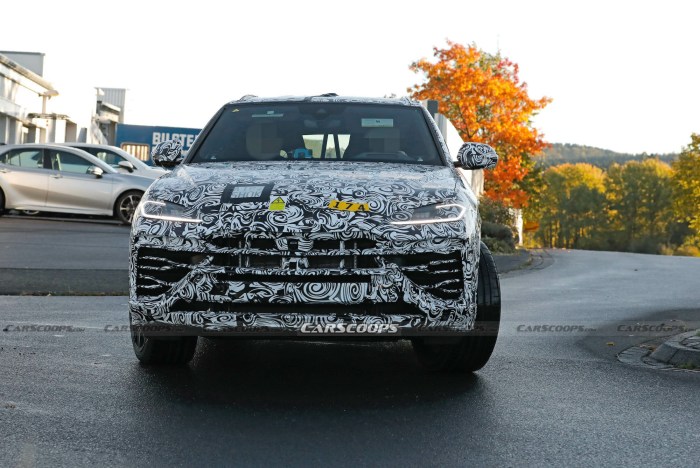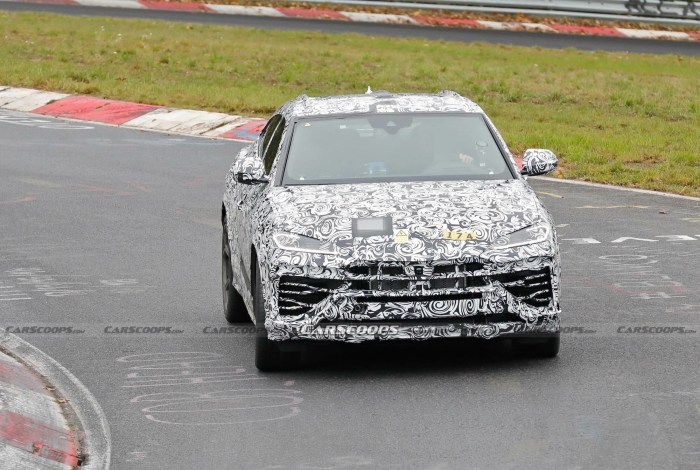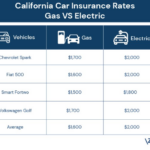Lamborghini Urus maintenance cost 2025: Yeah, so you’re thinking about snagging a Urus, huh? Sweet ride, but let’s be real – owning a Lamborghini isn’t cheap. This isn’t your grandpa’s Buick; we’re talking serious coin for upkeep. This guide dives deep into what you can expect to shell out for maintenance in 2025, from routine oil changes to those uh-oh, major repair moments.
We’ll break down costs, compare it to other luxury SUVs, and even touch on DIY vs. pro service. Buckle up, it’s gonna be a pricey ride.
We’ll cover everything from scheduled maintenance like oil changes and filter replacements to the potential for more serious repairs, like engine or transmission issues. We’ll also explore how your driving habits and insurance coverage can impact your overall maintenance budget. Think of this as your survival guide to keeping your Urus purring (and your wallet relatively intact).
Lamborghini Urus 2025 Maintenance Overview

Owning a Lamborghini Urus is a statement, but maintaining its peak performance requires a significant financial commitment. This overview details the expected maintenance needs for a 2025 Urus, providing a realistic picture of the costs involved. Remember that these are estimates, and actual costs can vary based on your location, dealer, and driving habits. Always consult your owner’s manual and your Lamborghini dealership for the most accurate and up-to-date information.Maintaining a Lamborghini Urus involves a blend of routine servicing and more extensive, periodic major maintenance.
Routine tasks, like oil changes, are relatively frequent and less expensive, while major services, such as brake replacements or transmission fluid flushes, are less frequent but significantly more costly. Understanding this distinction is key to budgeting effectively for your Urus’s upkeep.
Routine Maintenance Schedule
Routine maintenance for a Lamborghini Urus typically involves regular checks and replacements of essential fluids and filters. These services are crucial for maintaining the engine’s health and preventing premature wear and tear. Neglecting these seemingly minor tasks can lead to more significant and costly problems down the line. For example, failing to change the oil regularly can lead to engine damage requiring a costly rebuild.
| Maintenance Item | Frequency | Estimated Cost (USD) | Notes |
| Oil Change (with filter) | Every 5,000 – 7,500 miles or 6 months | $500 – $800 | Use only Lamborghini-approved oil. |
| Air Filter Replacement | Every 15,000 – 20,000 miles | $200 – $300 | Essential for optimal engine performance. |
| Cabin Air Filter Replacement | Every 15,000 – 20,000 miles | $100 – $150 | Improves air quality inside the vehicle. |
| Tire Rotation and Balance | Every 5,000 – 7,500 miles | $150 – $250 | Maintains even tire wear. |
| Brake Fluid Flush | Every 2 years or 24,000 miles | $300 – $500 | Ensures optimal braking performance. |
Major Maintenance Services
Major maintenance services for the Lamborghini Urus are less frequent but significantly more expensive than routine maintenance. These services often involve more extensive work and the replacement of more expensive components. For example, replacing the brakes on a high-performance vehicle like the Urus will naturally cost more than a standard car. Planning for these costs is crucial to avoid unexpected financial burdens.
| Maintenance Item | Frequency | Estimated Cost (USD) | Notes |
| Spark Plug Replacement | Every 30,000 – 40,000 miles | $800 – $1200 | Use only Lamborghini-specified spark plugs. |
| Transmission Fluid Flush | Every 60,000 miles | $1000 – $1500 | Essential for smooth shifting and longevity. |
| Brake Pad and Rotor Replacement (Front and Rear) | Every 30,000 – 50,000 miles (varies greatly with driving style) | $2000 – $4000 | High-performance brakes wear faster than standard brakes. |
Cost Breakdown of Routine Maintenance
Owning a Lamborghini Urus, even the 2025 model, means accepting a premium price tag extends beyond the initial purchase. Routine maintenance costs are significantly higher than your average SUV, reflecting the car’s high-performance engineering and exclusive parts. Let’s dive into the specifics.
Several factors heavily influence the total cost of routine maintenance. These include the cost of parts (often sourced directly from Lamborghini or specialized suppliers), the labor rates charged by authorized Lamborghini service centers (which tend to be significantly higher than independent shops), and the geographic location of the service center (labor and parts costs vary regionally).
Routine Maintenance Cost Categories
A typical annual maintenance schedule for a Lamborghini Urus would include several key areas. These areas contribute differently to the overall cost, and understanding this distribution is crucial for budgeting.
| Maintenance Item | Estimated Cost (USD) | Notes |
|---|---|---|
| Oil Change (including filter) | $500 – $800 | Specialized high-performance oil and filter are required. |
| Brake Pad Replacement (front & rear) | $1,500 – $2,500 | High-performance brake systems necessitate more expensive pads. |
| Tire Rotation & Balance | $200 – $400 | High-performance tires are costly, and proper maintenance is crucial. |
| Fluid Top-offs (coolant, brake fluid, etc.) | $100 – $300 | Regular checks and top-offs are essential for optimal performance. |
| Scheduled Inspections | $300 – $500 | Comprehensive checks by trained technicians. |
These costs are estimates and can vary based on the specific service center, parts used, and any additional repairs needed.
Comparison to Similar Luxury SUVs
Comparing the Urus’s maintenance costs to similar luxury SUVs like the Porsche Cayenne Turbo GT or the Bentley Bentayga is insightful. While precise figures vary depending on the specific service and location, it’s safe to say that the Lamborghini generally sits at the higher end of the spectrum. Expect to pay a premium for parts and labor compared to these competitors.
The exclusivity and high-performance nature of the Urus drive up these costs.
Cost Distribution Bar Chart
The following describes a bar chart visualizing the cost distribution across the different routine maintenance items. The horizontal axis represents the maintenance items (oil change, brake pads, tires, fluids, inspections), and the vertical axis represents the estimated cost range in USD. Each maintenance item is represented by a bar whose height corresponds to its cost range. For example, the “brake pad replacement” bar would be significantly taller than the “tire rotation” bar, reflecting the substantially higher cost of brake pad replacement.
The chart clearly shows that brake pad replacement and oil changes are the most significant contributors to the overall routine maintenance cost, while fluid top-offs and inspections have relatively lower costs.
Major Repairs and Their Costs
Owning a Lamborghini Urus, even in 2025, means accepting the reality of potentially hefty repair bills. While routine maintenance keeps the beast running smoothly, major mechanical issues can strike, leading to significant expenses. Understanding these potential costs is crucial for budgeting and financial planning. This section will delve into common areas requiring major repairs and the factors that influence their overall cost.The high-performance nature of the Urus, coupled with its sophisticated technology, makes it susceptible to certain types of major repairs.
These repairs can range from relatively straightforward fixes to incredibly complex and expensive interventions. The age of the vehicle, its driving conditions, and the owner’s maintenance habits all play a role in determining the likelihood and cost of these repairs.
Common Areas Prone to Major Repairs
The Urus, like any high-performance vehicle, has several components that are more prone to failure than others. These are often the most expensive to repair. Understanding these weak points allows for proactive maintenance and potentially reduces the severity (and cost) of future repairs.
So, you’re balling in a Lamborghini Urus in 2025? Sweet ride, but let’s be real, the maintenance is gonna be brutal. Totally different ballgame from worrying about things like upgrading your Ford F-150 Lightning’s infotainment system with a slick wireless CarPlay adapter, like the ones you can find at Wireless CarPlay adapters for Ford F-150 Lightning.
Seriously though, budgeting for that Lamborghini Urus upkeep is probably going to be a bigger headache.
- Engine: The twin-turbocharged V8 engine, while powerful, is a complex piece of machinery. Major repairs, such as needing a new turbocharger or addressing internal engine damage, could easily cost tens of thousands of dollars. For instance, replacing a turbocharger alone might range from $5,000 to $15,000 depending on the specific issue and labor costs.
- Transmission: The sophisticated eight-speed automatic transmission is crucial for the Urus’s performance. Major transmission problems, such as internal damage or failure of key components, can lead to extremely costly repairs. Rebuilding or replacing the transmission could easily reach $10,000 to $25,000 or more.
- Suspension: The Urus’s advanced suspension system, designed for both on and off-road performance, incorporates complex air springs and sophisticated electronics. Replacing air springs, repairing leaks in the air lines, or dealing with electronic control module failures can result in repair bills ranging from $3,000 to $10,000 depending on the extent of the damage.
- All-Wheel Drive System: The sophisticated all-wheel-drive system is critical for the Urus’s handling and performance. Failures in the differential, transfer case, or associated components can lead to expensive repairs. Repair costs can vary widely depending on the specific component that fails, ranging from several thousand to upwards of $15,000.
Factors Affecting the Cost of Major Repairs
Several factors contribute to the final cost of a major repair. These factors can significantly impact the overall expense, making accurate prediction challenging.
- Part Availability: Lamborghini parts, especially for a relatively new model like the 2025 Urus, might not always be readily available. This can lead to longer repair times and potentially higher costs due to expedited shipping or sourcing parts from less-conventional channels.
- Labor Rates: The specialized skills required to repair a Lamborghini Urus command a high labor rate. This is a significant portion of the overall repair cost, especially for complex repairs.
- Warranty Coverage: The existence and extent of any remaining factory warranty or extended warranty coverage will significantly influence the out-of-pocket expenses. A comprehensive warranty can cover a substantial portion of the repair costs, while an expired warranty leaves the owner responsible for the full amount.
- Dealer vs. Independent Shop: Repairing a Lamborghini at an authorized dealer will typically be more expensive than using an independent repair shop. Dealers usually charge higher labor rates and use only genuine Lamborghini parts. Independent shops may offer more affordable alternatives, but may not have the same level of expertise or use genuine parts.
Potential Major Repairs with Estimated Cost Ranges
It’s important to remember that these are estimates, and actual costs can vary based on the factors mentioned above.
- Engine Overhaul: $20,000 – $50,000+
- Transmission Replacement: $15,000 – $30,000+
- Air Suspension Repair/Replacement: $3,000 – $12,000
- All-Wheel Drive System Repair: $5,000 – $20,000+
- Major Electrical System Failure: $5,000 – $20,000+
Impact of Vehicle Usage on Maintenance Costs: Lamborghini Urus Maintenance Cost 2025
Your Lamborghini Urus’s maintenance bill isn’t just about the car itself; it’s heavily influenced by how you drive it. Think of it like this: a gentle Sunday drive is vastly different from a high-octane track day, and that difference shows up directly in your wallet. The more you push your Urus, the harder it works, and the faster its components wear down.Different driving styles and usage patterns directly impact the frequency and cost of needed maintenance.
Aggressive driving, frequent high-speed runs, and off-road adventures put significantly more stress on the engine, transmission, brakes, and suspension. Conversely, a more relaxed driving style, primarily used for commuting, will generally result in lower maintenance costs over time.
High-Performance Driving and Off-Road Use Increase Maintenance Expenses
High-performance driving, such as track days or spirited acceleration, generates extreme heat and stress on various components. This can lead to premature wear and tear on brake pads and rotors, tires, and even the engine itself. Imagine the intense heat generated during repeated hard braking – it’s significantly higher than during normal city driving, leading to quicker wear and more frequent replacements.
Similarly, off-road use exposes the Urus to harsh conditions, increasing the risk of damage to the undercarriage, suspension components, and tires. Rocks, bumps, and mud can cause significant damage, requiring costly repairs or replacements. For example, a single off-road excursion resulting in a bent control arm could easily cost several thousand dollars to repair.
Daily Commuting Versus Weekend Driving
A Lamborghini Urus used for daily commuting will accumulate mileage faster than one used primarily for weekend drives. This higher mileage translates to more frequent oil changes, tire rotations, and other routine maintenance tasks. However, the wear and tear on components might be less severe compared to a vehicle subjected to frequent high-performance driving. A Urus primarily used for weekend leisure driving, even if it occasionally experiences spirited driving, will generally experience less wear and tear on its mechanical components compared to a daily commuter.
The cumulative stress on the vehicle is simply lower.
Mileage and Specific Maintenance Procedures
Mileage is directly correlated to the need for specific maintenance procedures. The owner’s manual will specify recommended service intervals based on mileage. Reaching certain mileage thresholds triggers the need for major service items like timing belt replacements (if applicable), transmission fluid flushes, and coolant flushes. Ignoring these mileage-based maintenance requirements can lead to more significant and costly problems down the line.
For instance, neglecting a timely timing belt replacement can result in catastrophic engine damage, a repair far exceeding the cost of preventative maintenance. Ignoring recommended maintenance based on mileage essentially increases the risk of expensive, unexpected repairs.
Insurance and Warranty Considerations

Owning a Lamborghini Urus, even the 2025 model, means facing significant maintenance costs. However, insurance and warranty coverage can substantially mitigate these expenses, making a big difference in your overall ownership experience. Understanding how these protections work is crucial for effective budget planning.Insurance coverage plays a vital role in reducing unexpected repair bills. Comprehensive insurance policies typically cover damage from accidents, theft, and even certain types of weather-related events.
While this doesn’t directly address routine maintenance, it protects you from catastrophic repair costs that could easily reach tens of thousands of dollars. Furthermore, some policies include roadside assistance, potentially saving you towing fees and other emergency expenses.
Impact of Insurance Coverage on Maintenance Costs
Insurance doesn’t cover routine maintenance like oil changes or tire rotations. However, it acts as a safety net against unforeseen circumstances. For instance, if a deer runs into your Urus, causing significant body damage, your comprehensive insurance will likely cover the substantial repair costs. Similarly, if your car is stolen and recovered with damage, insurance will help defray those repair expenses.
Without comprehensive insurance, you’d be responsible for the entire cost, a potentially crippling financial blow. Liability insurance, while mandatory in most states, only covers damages to other vehicles or property; it won’t cover repairs to your Urus.
Warranty Coverage and Repair Expenses
The Lamborghini Urus likely comes with a factory warranty covering defects in materials and workmanship for a specific period. This warranty significantly reduces repair costs for issues arising from manufacturing flaws. For example, if the engine develops a problem due to a faulty part within the warranty period, Lamborghini would typically cover the repair at no cost to you.
However, warranties usually exclude damage caused by accidents, misuse, or neglect. It’s crucial to understand the terms and conditions of your specific warranty to avoid misunderstandings.
Influence of Insurance Plans and Warranty Options on Maintenance Budgeting
Choosing a comprehensive insurance policy with higher coverage limits will increase your premiums but provide greater protection against costly repairs. Similarly, extended warranty options offered by Lamborghini or third-party providers can offer additional coverage beyond the factory warranty, but at an extra cost. Carefully evaluating the potential cost savings against the added premiums is essential for sound financial planning.
So, you’re thinking about a Lamborghini Urus in 2025? Yeah, that’s a baller ride, but let’s be real, the maintenance costs are gonna be insane. To offset some of that, maybe consider the environmental impact and check out some alternatives like the Best EVs with vehicle-to-grid (V2G) technology , which could even help you recoup some costs.
Ultimately though, that Lamborghini Urus maintenance is going to be a major budget item.
Consider the likelihood of needing major repairs and your risk tolerance when making these decisions. A younger driver with a less-than-perfect driving record might opt for a more comprehensive insurance policy, while an older, experienced driver might choose a plan with a higher deductible to lower their premiums.
Examples of Cost Reduction through Insurance or Warranty
Scenario 1: A hailstorm causes significant damage to your Urus’s paint and bodywork. Comprehensive insurance covers the costly repairs, preventing a potentially $15,000 – $20,000 out-of-pocket expense.Scenario 2: A manufacturing defect causes a failure in the Urus’s transmission within the factory warranty period. The warranty covers the complete repair, saving you potentially $10,000 or more.Scenario 3: You accidentally back into a wall, causing damage to your rear bumper.
Collision insurance (part of comprehensive coverage) covers the repair, preventing a $5,000 – $7,000 expense. However, your deductible would apply.
Maintaining a Lamborghini Urus

Owning a Lamborghini Urus is a significant investment, and maintaining its performance and longevity requires careful consideration of maintenance strategies. The decision of whether to handle maintenance tasks yourself or rely on professional services is crucial, impacting both your wallet and the vehicle’s health. This section explores the trade-offs between DIY maintenance and professional servicing for your Urus.
DIY vs. Professional Service for Lamborghini Urus Maintenance
The choice between DIY and professional maintenance for your Lamborghini Urus involves a careful weighing of costs, skills, and risks. While some straightforward tasks might be manageable for a mechanically inclined owner, others demand the expertise and specialized tools of a professional Lamborghini service center. Incorrect DIY repairs can lead to significant damage and void warranties, ultimately costing far more than professional service.
Cost and Benefit Comparison: DIY vs. Professional Service, Lamborghini Urus maintenance cost 2025
Performing maintenance tasks yourself can offer potential cost savings, particularly for routine checks and simple fluid changes. However, these savings are offset by the investment in specialized tools, potentially expensive parts if mistakes are made, and the time commitment required. Professional service, while more expensive upfront, guarantees proper repair using factory-specified parts and techniques, minimizing the risk of damage and preserving your warranty.
The peace of mind offered by professional service is a significant factor to consider.
Suitable Tasks for DIY and Professional Service
Certain maintenance tasks are better suited for DIY efforts than others. Simple tasks like checking fluids (oil, coolant, brake fluid) and tire pressure are relatively straightforward and safe for DIY. However, more complex tasks like brake pad replacements, timing belt changes, or any work involving the sophisticated electronics and engine management systems of the Urus should absolutely be left to trained professionals.
Improper handling of these systems can cause serious damage and potentially void warranties.
Cost Savings and Risks of DIY Maintenance
The potential cost savings of DIY maintenance are attractive, but the risks associated with improper repairs can easily outweigh any financial benefits. For example, incorrectly bleeding brakes can compromise braking performance, leading to dangerous situations. Similarly, improper engine work could result in significant engine damage, costing thousands of dollars in repairs. The value of your Lamborghini Urus warrants careful consideration of these risks.
| Task | DIY Cost (Estimate) | Professional Cost (Estimate) | Recommendation |
| Fluid Level Checks (Oil, Coolant, Brake Fluid) | $0 (assuming you own a dipstick and tools) | $100 – $200 (diagnostic and basic inspection) | DIY (with proper knowledge) |
| Tire Pressure Check & Inflation | $0 (assuming you own a pressure gauge) | $50 – $100 | DIY |
| Brake Pad Replacement | $100 – $300 (parts + labor) | $500 – $1000 (parts + labor) | Professional |
| Timing Belt Replacement | $500 – $1000 (parts + potential damage) | $2000 – $4000 (parts + labor) | Professional |
| Engine Diagnostics | $0 – $100 (basic code reader) | $200 – $500 | Professional (for accurate diagnosis) |
Final Conclusion
So, there you have it – the lowdown on Lamborghini Urus maintenance costs in 2025. While the initial sticker shock might be intense, understanding the potential expenses beforehand is key. Remember, regular maintenance can actually help prevent costly repairs down the line. Weighing the pros and cons of DIY vs. professional service, factoring in insurance, and being mindful of your driving style can all help you manage those expenses.
Now go forth and conquer the open road (responsibly, of course!).









